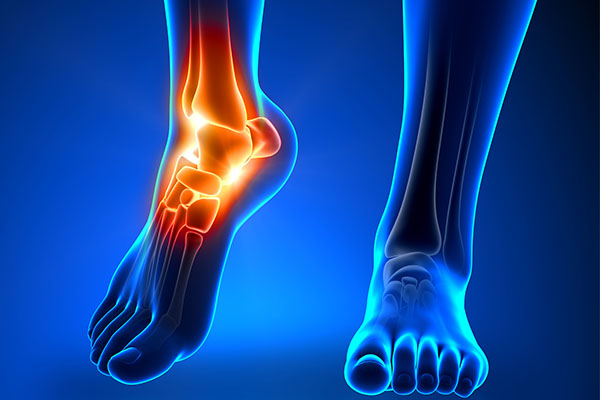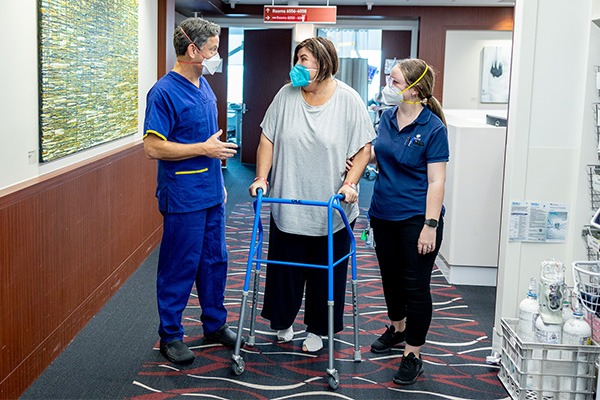Overview
Epworth provides state-of-the-art facilities and advanced medical technology to deliver the best possible foot and ankle care for patients. Our orthopaedic specialists are experienced in treating various foot and ankle conditions, including sprains, fractures, Achilles tendonitis, plantar fasciitis, and arthritis.
-
What is the ankle joint?
The ankle joint is a hinge joint formed between the tibia and fibula (bones of the lower leg) and the talus (a bone of the foot) and allows the foot to bend upwards and downwards. The joint also allows a small amount of rotation.
-
Can my injury be treated without surgery?
The immediate treatment of any foot or ankle injury includes rest, ice, compression, elevation, and referral. RICE protocol should be followed for 48 – 72 hours. The ankle should be rested in an elevated position with an ice pack applied for 20 minutes every two hours.
-
When is foot or ankle surgery recommended?
If you have recurrent pain or finding it difficult to do everyday activities such as walking, our orthopaedic surgeons may recommend surgery to increase mobility and reduce pain.
Below are some broad signs that should prompt you to consult your GP to get a referral to an Epworth specialist:
- Pain during activity.
- Stiffness and swelling that doesn’t go away.
- Pain that severely impacts your quality of sleep.
- Reduction in your quality of life or avoidance of activities you enjoy because pain.
Conditions
Common conditions and injuries which may require surgery
Ankle sprain
- Ankle sprains typically occur when ligaments are damaged when the foot twists inward.
Talofibular
- Talofibular is a ligament injury that results in swelling and pain on the outside of the ankle. If the force is severe, the calcaneofibular ligament in the ankle may also be damaged. A complete tear of all ankle ligaments may result in a dislocation of the ankle joint and an accompanying fracture.
Foot fracture
- A foot fracture is an injury to one or several of the bones in your foot. A foot fracture can happen because of over overuse, trips or falls and car accidents.
Ankle fracture
- A rotational injury typically causes an ankle fracture. A rotational injury is when the ankle joint is twisted or rolled during exercise, walking, a high-impact fall or other collision.
Common foot and ankle conditions
Bunions
- Bunions typically develop slowly and are caused by consistent pressure on the big toe joint, resulting in the big toe leaning toward the second toe. Over time, pressure on the big toe pushes the bone, tendons, and ligaments to change position and causes pain during daily activities such as walking.
Osteoarthritis
- Osteoarthritis is the most common form of ankle arthritis, where the cartilage in the ankle joint gradually wears away. This can lead to pain as the joint can’t move as easily.
Diagnosis
The Orthopaedic Unit has dedicated teams of nursing, medical and allied health staff to expertly manage and evaluate all orthopaedic conditions.
Evaluation for foot or ankle surgery
Once you have received a referral from your GP, you will be able to book an appointment with an Epworth specialist. Your specialist will then assess your X-rays, medical history, and physical exam to provide personalised treatment options.
Medical imaging
- During the early stages of investigation, your doctor will likely arrange X-rays or Magnetic Resonance Images (MRIs) images to examine your bones.
Medical history
- Your specialist will ask you questions about your ability to perform everyday activities, pain level and general health.
Physical exam
- During your consultation, your doctor will perform a physical exam to assess your mobility and strength.
Fees
When booking an appointment with your specialist, you can speak with their administrative team to understand the fee for the consultation. We then recommend speaking with your insurance company to determine your out-of-pocket costs.
Treatment
Depending on a range of factors, your doctor will advise which type of ankle or foot treatment is best for you.
Foot and ankle treatment examples:
-
Non-surgical treatmentDepending on your injury or condition, you may be recommended to make lifestyle changes or non-surgical interventions such as pain medication or using a walking aid or ankle boot. Physical therapy and rehabilitation may also be suitable to help you manage the symptoms associated with your condition. If non-surgical options are no longer reducing your symptoms, we encourage you to speak with your doctor about alternative treatment.
-
Ankle joint replacementAn ankle joint replacement, also known as ankle arthroplasty, is a type of surgery that aims to reduce pain and improve movement and quality of life by replacing damaged bones or cartilage with artificial parts.
-
Ankle fusionAnkle fusion, also known as ankle arthrodesis, is typically recommended to treat acute arthritis in the ankle. Ankle fusion surgery fuses two ankle bones to reduce pain and swelling.
-
Total ankle replacementTotal ankle replacement surgery is recommended for patients with extensive ankle damage, requiring the ankle to be replaced with plastic or metal parts
-
Revision ankle replacementAll joint replacements will need to be replaced eventually; this is known as revision surgery. Depending on your age and lifestyle factors (such as weight), your ankle replacement will typically last around 15 years before revision surgery is needed.
-
Ankle ligament reconstructionAnkle ligament reconstruction surgery may be recommended following an ankle sprain or ankle instability. Epworth provides patients with several different ligament reconstruction surgeries. Ligament reconstruction surgeries are surgical procedures to replace, tighten or secure one or more torn ligaments.
-
Bunion correction surgeryBunion surgery is typically recommended if the pain interferes with daily activities, such as walking. Bunion surgeries aim to realign your toe, remove swollen tissue, or fuse the affected bone.
Deciding whether surgery is right for you
The decision to undergo foot or ankle surgery is a collaborative one. We encourage you to speak with your family, GP and orthopaedic surgeon. The more you know, the easier it will be to decide whether this surgery is right for you.
Fees and private health
Once you speak with your specialist, you’ll be provided with the relevant information to give your insurance company. Your insurer will provide you with the breakdown of treatment fees.Find your Epworth specialist
Our locations
Foot and ankle treatment locations:
Preparing for surgery
We are here to support patients and their families in preparing for surgery.
We encourage you to view the videos below, which outline the patient journey to give you the confidence to be an active participant from your pre-operative exercise program through to your return home and post-surgery recovery.
To learn more about your anaesthetist's role during the surgery and what to expect beforehand, watch the video below.
Home preparation
Occupational therapists recommend you review your home environment and implement simple modifications, moving trip hazards such as rugs and cords from walkways to ensure your home is safe following your surgery.
Rehabilitation
Epworth Rehabilitation programs aren’t just something to consider after surgery. Our rehabilitation programs can also support people preparing for joint replacement or ligament surgery.
Ordering assistive aids
Recovery
Our aim is to provide you with comprehensive and compassionate recovery care that will help you return to an independent and functional lifestyle as possible.
The day after your surgery
We are here to support you to get back to your life as soon and as safely as possible. Your care team will often try to get you moving the day after your operation. This will support your recovery and reduce the likelihood of complications, so you can book your next holiday, get back to playing sport, or return to work sooner.
Physiotherapy
Your physiotherapist will assist you in completing a daily walking and exercise program. The planned exercises aim to restore the range of movement and muscle strength.
Pain management
It is normal to have some pain following major surgery. By controlling your pain as best we can, you are likely to recover faster. The team caring for you will offer you medications to manage your pain, enabling you to participate in your walking and exercise program. It is important to be proactive in asking for pain relief. As your pain improves, you will gradually require less pain medication. You will be supplied with pain relief medication on discharge.
Rehabilitation
Depending on your personal needs and your GP or surgeon’s recommendations, you may be referred to a rehabilitation program.
How rehabilitation supports your recovery
Guided by regular support from Epworth physiotherapists and occupational therapists, rehabilitation will help you to feel stronger, safer and more confident to participate in everyday life activities.
To learn more about what you can expect from your rehabilitation program, please watch the video below.
Rehab after your joint replacement surgery
Achieve your post-surgery goals
Our rehabilitation team will assess and develop a specific rehabilitation program based on individual needs and goals. Your program will consider factors such as pain, arthritis, movement, and personal goals such as returning to work or sport.
Rehabilitation programs
There are a few ways you can access our rehabilitation programs. Your surgeon and care team will work with you to identify the best option:
Rehabilitation at home
- A physiotherapist will visit you at home and develop a program you can complete in your local area. Our team will also connect you to local services such as gyms and pools if it benefits your recovery. The team will also recommend equipment you may like to purchase or hire to support recovery and long-term health.
Outpatient program
- Outpatient program involves visiting the hospital a few times a week to complete your rehabilitation program.
Inpatient program
- If you are recommended an inpatient program, you will stay in our rehabilitation hospital for about 5-7 days after your surgical admission.
Why choose Epworth for rehabilitation?
Epworth Rehabilitation offers patients access to an expert team of rehabilitation clinicians with purpose-built gymnasiums, hydrotherapy pools and other specialised rehabilitation equipment to support you.
Fees and health insurance
Depending on the level of your private health insurance, our rehabilitation services may be covered by your health fund. You can also choose to self-fund if you prefer. Whichever option you choose, we will provide you with the financial information when you are referred to Epworth Rehabilitation.


